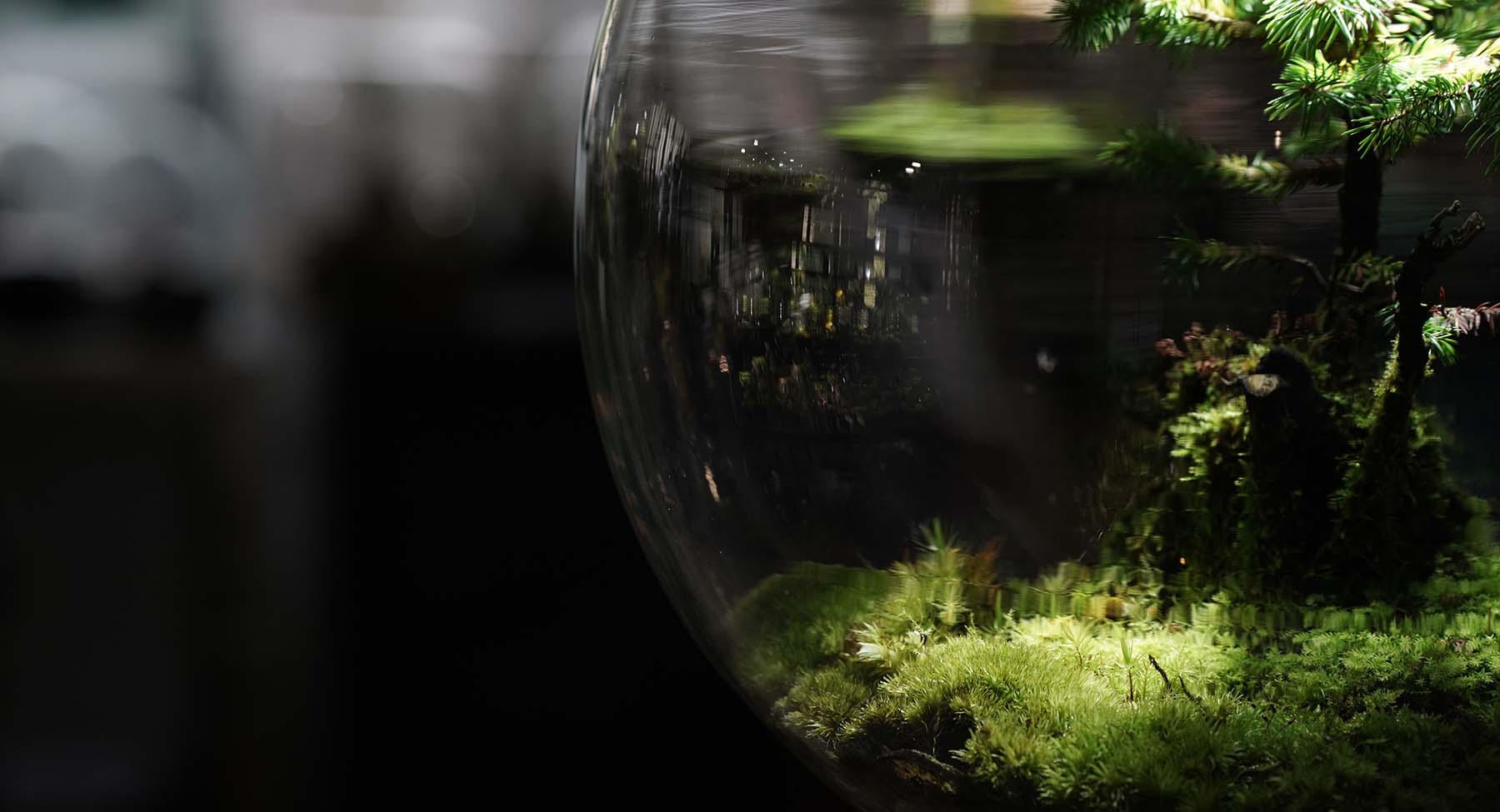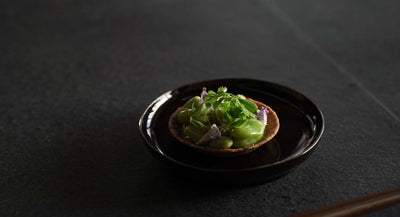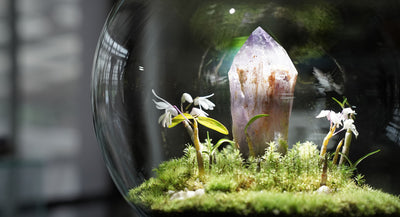宙に浮かぶ緑の球体は生物が住まう惑星そのものなのかもしれない。
村瀬の代表作「Space Colony」は太陽系を形成するかのごとく、空間を占領するように浮遊していた。
優しく淡い光で瞬く緑玉は鬱蒼と生い茂る森の一部を切り取ったかのような借景を思わせる。
住空間に溶け込むように佇むそれは自然と切り離されがちな現代人の眼前で自然のダイナミズムを示してくれる。
村瀬が目指すのは途切れることのない人と植物との「生命の循環」。
どちらかが欠けても成り立たない、相思相愛の関係性を模索し続ける。それは途切れることのない生命のコミュニケーションなのだ。
さぁ、今日も友の声に耳を傾けてみよう。
僕らは共に生きる同志なのだから。
前半"植物と求める独自の美学"
— 植物との出会いのきっかけを教えてください
育てる・愛でるとかではなく「遊び」を通しての出会いが植物に興味を持ったきっかけでした。幼少期はバブルという背景でゲームやマンガ、アニメのフィギュアが溢れていて、私も色々とコレクションをしていました。フィギュアをどうするかというと戦わせたり、並べて飾ったり。その時にふと、背景を見て寂しいなと感じたんです。なぜならゲームやアニメなど主役には背景があって活きるものですよね。そんな時にふと祖父が育てていた盆栽が目に入りました。小品盆栽をいくつか持ってきてフィギュアの後ろに置くとこれがちょうど良いサイズ感で。なので植物を玩具のように捉えていたんです。

他には思春期には水草を使って景色を模るアクアリウムを作ったり、社会人の頃はサボテンなどの観葉植物も大量にコレクションしました。大人になっても植物を玩具の1つとして捉えていたので元々は趣味として扱うことがほとんどで、植物に関する知識は独学で勉強をしました。
— 植物は遊び相手であり良き友のような関係性だったんですね
仕事として植物を扱うきっかけになったのは30歳前後に手がけたカフェの内装デザインでした。既にあった物件の内装をそのまま活かしたデザインにできないかと考えた時に出てきたキーワードが「廃墟」でした。当時、建物が植物に呑み込まれていくような神秘的でどこか怪しげな雰囲気に魅力を感じ、様々な廃墟巡りをしていました。無機質なマテリアルと植物のような有機物を掛け合わせた廃墟テイストのデザインを手がけたところメディアなどで話題になり、カフェの開業をきっかけに植物関係の依頼が舞い込むようになりました。

— そのタイミングで植栽家として活動を続けようと
大きなきっかけはカフェの内装を手がけたことですね。その後にはエナジードリンクのRed Bull主催のアートプロジェクトに参加したりもしました。ドリンクを保管する小型クーラーをキャンバスに見立ててアートピースを制作するのですが、苔だらけにした奇抜なデザインを関係者の方が評価してくださり、個展を開いてほしいとリクエストをいただくようにもなりました。仕事がそのままポートフォリオとなり新しい依頼をいただくというスタイルが多かったです。
— 植物との関わりが密接になる一方で、花や庭など近いカテゴリーの活動にも興味はありましたか
庭は変容していくデザインとして興味を持っていたのですが、正直なところ花にはあまり興味はなかったんです。今でこそ刹那から背景を想像させるいけばなをはじめ、花を扱われる方々と関わる機会が増え理解も深まりましたが、当時はその魅力がわかりませんでしたね。

私は人が手を加えた人工的な美しさより、自然に任せたあるがままの世界観に心惹かれているんです。その上で自然と花が発生したり、育成していく上で庭園っぽい世界観に繋がれば良いのかなと思っていて。自身が本懐として究極的に求めていることは「持続可能性」。植物たちが環境によってどの様な姿を魅せてくれるのか。根底にある命の循環を考え、作品としてアウトプットすることがものづくりにおいての信条です。
— 自然や命の理を意識した“循環する作品”を手掛けたいと思ったきっかけは何だったのでしょうか

私が拠点を置く京都という土地にも深く関係あるのですが「鰻の寝床」と呼ばれるように家や店舗が間口が狭く細長く連なっています。そしてなんといっても暗い。一方で植物は生き物なので水だけではなく光も必要です。こうした京都ならではの空間を目の当たりにして、暗い中でも植物が育ち、そして印象を与えられる作品ができないかと思いました。その時にアンティークショップでふと見つけたのがランプでした。元々は船の照明で使われていたのですが「ランプの中に植物を入れて光を当ててあげたら暗い空間でも飾れる植物のインテリアができるのでは」と。幼少期のアクアリウムの経験からライトを当てたら水草が育つことは知識としてあったので、現代だとLEDライトを使用すればより手軽に再現できるのではと思いつき、誕生したのが「Space Colony」という作品です。
— ご自身の中で「Space Colony」の魅力はどこにあると感じますか
アイコニックなところではないでしょうか。かつ受け取り側次第でプロダクトともアートピースとも捉えていただけるのかなと。

「Space Colony」という作品は付き合い方が正しければ持続し変化していきます。インテリアや建築と植物との共生とでもいいますか、現代の住空間にどれだけ溶け込むデザインにできるかという命題です。「Space Colony」では円を描くミニマルな形状にすることで店舗だけではなくギャラリーやお茶室など、どんな空間でもその雰囲気を邪魔することがないニュートラルでミニマルなデザインだと思います。
作品を通じて球体の中にあるミクロの世界と、作品が置かれている空間そのものの世界それぞれに興味を持ってもらえるレンズのような役割ができたら嬉しいです。
— 非常にインタラクティブな機能を持ち合わせていると感じます
ただ私の願いとしてはそこからもう一歩、歩み寄ってもらいたいという気持ちがあります。「Space Colony」はLEDの光源の下、地表が目線に来るようにセットされることで、通常そこまで注視しないような矮小な植生世界が良く見えます。土中もガラスで透けていますので、根はこのように広がるんだ、苔にも色々な形があるんだ、石もここまで豊かに表情があるんだ、と自然そのものの繊細な造形を感じた上で、再度本来の自然界に疑問や好奇心を持って触れていただきたいですね。
— 創作をする上でのポリシーのようなものはあるのでしょうか

「自分で作品を完成させないこと」ですね。手渡したひとりひとりに楽しんでもらえるような余白を残す。ディテールの部分だと360°どこから見ても美しいと思えるデザインを徹底しています。一応、作品の顔となる正面は決めますがコレクターそれぞれに好きな景色を見つけてもらい自分だけの作品として楽しんでもらうために“未完成”という余白を敢えて残します。手渡して終わり、飾って終わり、ではなく、そこからが作品としての始まり。植物との共生の第一歩になるんです。
“Bringing light to life. A creator of verdant ecosystems.”-Takaaki Murase(Planter)
The green spherical ecosystems that are suspended in the space may be actual planets. Murase’s “Space Colony” series occupies the space, arranged to resemble a solar system.
The green spheres that twinkle in soft faint light are samples of borrowed scenery that seem like cut-out patches of dense forests. The works that fuse magnificently with living spaces provide fragments of nature’s dynamism to modern people that have become detached from nature.
What Murase strives to achieve is a seamless cycle of life between people and plants. He continues to explore this mutual relationship which is incapable of functioning when either is lacking. This is an example of a seamless communication between the two lifeforms.
So, again today, let’s hear what our little green friends have to say.
We are, after all, companions of the same symbiotic system.
“Plants and Exploring Unique Aesthetics”
— Please tell us how you became fascinated with plants.
I didn’t become fond of plants simply by growing or observing them. I became interested in them through play. I was a child during the bubble economy period, and grew up with a wide assortment of video games, mangas, and action figures to play with. I even collected some myself. I would make the action figures fight each other and line them up as décor for my room. However, I felt that the look of these action figures without a lively background felt quite insufficient. I mean, the main protagonists of video games and anime don’t come to life without a backdrop. This is when I discovered my grandfather’s bonsai trees. I placed some of my grandfather’s small bonsai trees behind my action figures and realized their sizes were perfect as backdrops. Therefore, I had always viewed plants as toys.
Additionally, during my adolescent years, I would make aquariums, recreating various scenes using waterweeds. I also had a large collection of house plants such as cacti when I became a working adult. Even then, I considered plants as toys and mainly collected them as a hobby. Therefore, my knowledge of plants was acquired through self-education.
— So, plants were your playmates as well as your good friends.
I first started my career working with plants around my thirties when I received an offer to design the interior of a café. I had planned to decorate the space using the pre-existing interior of the property. Therefore, the concept I had for the design was heavily inspired by the looks of city ruins. At the time, I was fascinated by the mystic atmosphere of buildings engulfed by greens and regularly went on trips to visit various ruins. My design that blended inorganic materials and organic materials such as plants went viral across various media, and I started to receive plant related job offers after the café opened.
— Was this where you decided to continue your activities as a planter?
Designing the café interior was definitely a major catalyst. I then went on to participate in an art project led by Red Bull, an energy drink brand. I created a bizarre art piece by covering their drink coolers with moss. Their design was highly regarded by everyone involved and I began receiving requests to host my own exhibition. Most of the time, the design jobs I received ended up becoming my portfolio.
— Through your fascination for plants, have you ever had an interest in similar categories such as flowers and gardening?
I did have an interest in gardening for its transforming design features. However, I was not especially fond of flowers. Now, I’ve actually started practicing ikebana for its ephemeral characteristics and even gained more of an understanding for flowers through exchanges with florists, but back then, I wasn’t particularly interested.
I am more intrigued by organic designs rather than something that is man-made. With that in mind, I seek to create work with garden like aesthetics by having flowers grow naturally. My true goal is to achieve sustainability and I am committed to continue creating work by contemplating the cycle of life, observing what organic designs the plants will exhibit depending on the environment.
— What motivated you to create work that circulate based on the laws of nature and life?
This is heavily related to the fact that I am based in Kyoto. Houses and stores here are known as eel beds since the buildings are consecutively aligned with long and narrow layouts. It is also worthy to note that it is dark here. On the other hand, in addition to water, plants need light to survive. Based on these features, I became interested in creating impressive art pieces that would enable plants to grow in dark environments. It was at this time I discovered some lamps that were originally used on ships at an antique shop. I imagined I would be able to create plant based interior décor if I placed the plants within these lamps and shined light on them. Since I was aware that waterweeds could be grown if you shined lights on them from my experiences creating aquariums as a child, I realized that I could use LED lights, which weren’t a thing back then, to create my work. This is how I came up with the “Space Colony” series.
— What do you think makes your “Space Colony” series fascinating?
I believe it is because it is iconic. Furthermore, depending on what my clients think of them, they can be both a product and art piece.
My “Space Colony” series will continue to change and can be sustained if handled correctly. It is a proposal to achieve a design that blends well with the contemporary living space. Specifically, it is a means to achieve a sense of coexistence between plants and interiors as well as architecture. I believe my “Space Colony” series, which takes a minimalistic spherical shape, is a neutral type of minimal design that fits perfectly in any space including stores, galleries, and tea rooms.
I hope that each of my pieces would act as a lens, that would gain the attention of their viewers, through their microscopic habitats confined within their spherical casings and environments they are installed in.
— They definitely seem to have an extremely interactive function.
However, I hope their viewers would delve another step deeper into my true intentions. By setting my “Space Colony” series under LED lights and hanging them so that the ground surface is at eye level, the miniature world of plants, that we don’t really pay much attention to, can be observed with ease. Since the layers under the soil can be seen through the transparent glass, I would like for their viewers to discover the fine details of nature, such as how roots spread, the variations in moss color and form, and the various expressions of stones, and revisit the origins of nature with new questions and interest.
— Do you have a policy when you create your work?
My policy is to keep my work unfinished. I try to leave intentional spaces for each of the owners of my work to enjoy. In terms of detail, I make sure to create my works in designs that look beautiful from any angle. I do specify the front face of my work, but I leave intentional spaces and keep them unfinished so their owners would be capable of enjoying the pieces by discovering their own scenes. My works are not complete once they are in the hands of collectors or when they are set up for viewing. Instead, this is where their stories begin. The first step to coexistence between man and plant.
Profile
Takaaki Murase / 村瀬 貴昭

幼少期に祖父の盆栽、思春期にアクアテラリウム、青年期に稀少植物のコレクターという趣味を持ちながら育つ。それら植栽を独学で試行錯誤を続けながら2012年より「Re:planter」としての活動を開始。 Re:cycle×Plantsをコンセプトに、京都に軸足を置きながら自然の理を探求し循環する生きた作品作りを続けている。
Grew up admiring his grandfather’s bonsai during his childhood, creating his own aquariums during his teens, and collecting rare species of plants during his youth. Self-taught as a planter, he began his activities as “Re:planter” in 2012. Based on his Re:cycle x Plants concept, he continues to create living works that revolve while exploring the laws of nature while residing in Kyoto.
【共同企画】
株式会社 無茶苦茶(Mucha-Kucha Inc.)
"Respect and Go Beyond"をミッションに日本の総合芸術である「茶の湯」
With the mission of "Respect and Go Beyond," the company is developing an art production business that raises the spirituality and aesthetics of the tea ceremony by "reinterpreting" the comprehensive Japanese art of "chanoyu" by crossing it with various domains such as technology and street culture.





